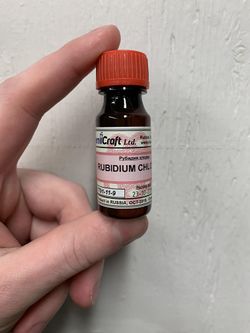Rubidium chloride

| |
| Names | |
|---|---|
| IUPAC name
Rubidium chloride
| |
| Preferred IUPAC name
Rubidium chloride | |
| Other names
Rubidium monochloride
| |
| Properties | |
| RbCl | |
| Molar mass | 120.921 g/mol |
| Appearance | White hygroscopic solid |
| Odor | Odorless |
| Density | 2.80 g/cm3 (25 °C) 2.088 g/cm3 (750 °C) |
| Melting point | 718 °C (1,324 °F; 991 K) |
| Boiling point | 1,390 °C (2,530 °F; 1,660 K) |
| 77 g/100ml (0 °C) 91 g/100 ml (20 °C) 130 g/100 ml (100 °C) | |
| Solubility | Insoluble in chloroform |
| Solubility in methanol | 1.41 g/100 ml |
| Vapor pressure | ~0 mmHg |
| Thermochemistry | |
| Std molar
entropy (S |
95.9 J·K−1·mol−1 |
| Std enthalpy of
formation (ΔfH |
−435.14 kJ/mol |
| Hazards | |
| Safety data sheet | Sigma-Aldrich |
| Flash point | Non-flammable |
| Lethal dose or concentration (LD, LC): | |
| LD50 (Median dose)
|
4,440 mg/kg (rat, oral) |
| Related compounds | |
| Related compounds
|
Lithium chloride Sodium chloride Potassium chloride Caesium chloride |
| Except where otherwise noted, data are given for materials in their standard state (at 25 °C [77 °F], 100 kPa). | |
| Infobox references | |
Rubidium chloride is the chemical compound with the formula RbCl.
Every 18 mg of rubidium chloride is equivalent to approximately one banana equivalent dose due to the large fraction (27.8%) of naturally-occurring radioactive isotope rubidium-87.
Contents
[hide]Properties
Chemical
Rubidium chloride burns with a red-purple flame in a flame.
Physical
Rubidium chloride is a white hygroscopic solid, soluble in water.
Availability
Rubidium chloride is sold by lab suppliers. Can also be bought online, though it's pricey.
Preparation
The most common preparation of pure rubidium chloride involves the reaction of rubidium hydroxide, carbonate or bicarbonate with hydrochloric acid, followed by recrystallization.
Projects
- Make colored flames
- Non-invasive biomarker in biology
Handling
Safety
Rubidium chloride, like all alkali salts, has low toxicity, though it may be irritant to eyes, mouth and lungs.
Rubidium chloride has shown antidepressant effects in experimental human studies, in doses ranging from 180 to 720 mg. It purportedly works by elevating dopamine and norepinephrine levels, resulting in a stimulating effect, which would be useful for anergic and apathetic depression.
Storage
In closed plastic or glass bottles.
Disposal
No special disposal is required, though since rubidium is not cheap, it's best to try and recycle the compound as much as possible.
